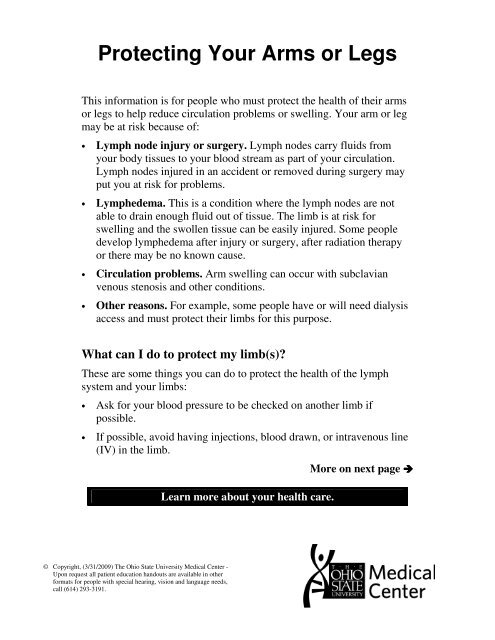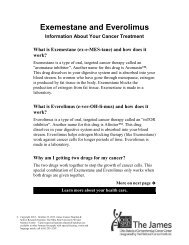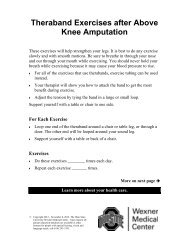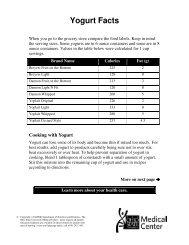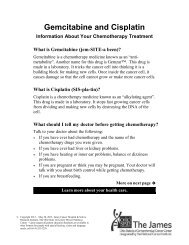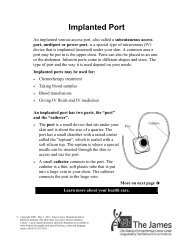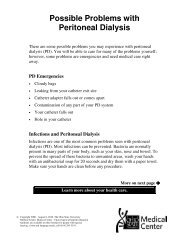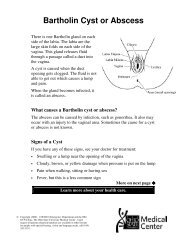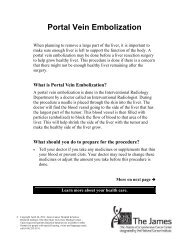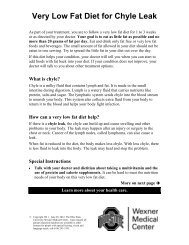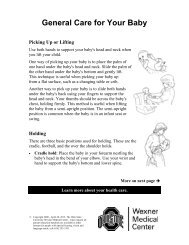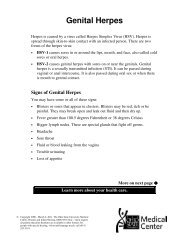English - Patient Education Home - The Ohio State University
English - Patient Education Home - The Ohio State University
English - Patient Education Home - The Ohio State University
Create successful ePaper yourself
Turn your PDF publications into a flip-book with our unique Google optimized e-Paper software.
Protecting Your Arms or Legs<br />
This information is for people who must protect the health of their arms<br />
or legs to help reduce circulation problems or swelling. Your arm or leg<br />
may be at risk because of:<br />
• Lymph node injury or surgery. Lymph nodes carry fluids from<br />
your body tissues to your blood stream as part of your circulation.<br />
Lymph nodes injured in an accident or removed during surgery may<br />
put you at risk for problems.<br />
• Lymphedema. This is a condition where the lymph nodes are not<br />
able to drain enough fluid out of tissue. <strong>The</strong> limb is at risk for<br />
swelling and the swollen tissue can be easily injured. Some people<br />
develop lymphedema after injury or surgery, after radiation therapy<br />
or there may be no known cause.<br />
• Circulation problems. Arm swelling can occur with subclavian<br />
venous stenosis and other conditions.<br />
• Other reasons. For example, some people have or will need dialysis<br />
access and must protect their limbs for this purpose.<br />
What can I do to protect my limb(s)?<br />
<strong>The</strong>se are some things you can do to protect the health of the lymph<br />
system and your limbs:<br />
• Ask for your blood pressure to be checked on another limb if<br />
possible.<br />
• If possible, avoid having injections, blood drawn, or intravenous line<br />
(IV) in the limb.<br />
© Copyright, (3/31/2009) <strong>The</strong> <strong>Ohio</strong> <strong>State</strong> <strong>University</strong> Medical Center -<br />
Upon request all patient education handouts are available in other<br />
formats for people with special hearing, vision and language needs,<br />
call (614) 293-3191.<br />
Learn more about your health care.<br />
More on next page
Page 2<br />
• Be cautious of temperature extremes, cold and heat (such as saunas or<br />
hot tubs).<br />
• Use care with razors, avoid nicks and skin irritation. Using an electric<br />
razor may be a good alternative.<br />
• Do not wear tight jewelry or elastic bands around the affected fingers,<br />
arms or legs.<br />
• Avoid cutting cuticles when manicuring your nails.<br />
• Keep skin clean and dry, apply daily moisturizer.<br />
• Try to keep your body weight under control through a well-balanced,<br />
low salt, low fat diet. Weight gain can increase swelling in the limbs.<br />
• If you get a scratch, bite, burn, or break in your skin, wash the area at<br />
once with soap and water. Cover with a bandage to keep it clean and<br />
protected. Check that it is healing at least daily.<br />
• Usually swimming, bike riding, walking, some ballet or yoga<br />
movements are good to help your limbs. If an activity causes a limb<br />
to swell, then it may not be a good one for you. Talk to a physical<br />
therapist about sports or activities if exercises cause your limb(s) to<br />
swell or if you already have lymphedema.<br />
• Keep your limb(s) protected from the sun and insects.<br />
• If you have swelling in a limb, then elevate it to help the fluid drain<br />
better.<br />
• If legs are involved, avoid prolonged standing or sitting, when<br />
possible avoid crossing legs, wear proper, well-fitting footwear.<br />
If you are trying to protect the arm(s),<br />
• Do not carry heavy handbags or luggage using shoulder straps.<br />
• Squeeze a soft ball in your hand.<br />
• Wear gloves during activities like gardening or washing dishes, when<br />
you could be injured.
What we do to protect your limb(s).<br />
Page 3<br />
At this hospital, staff may use special reminders. Staff will put up a sign<br />
in the room and ask you to wear a pink band on your limb(s). This is<br />
done to try to avoid doing blood draws, IV's or blood pressure in a limb<br />
that is at-risk.<br />
Having procedures done to the limb cannot always be avoided. But, it is<br />
a good idea to reduce risk and avoid this when you can.<br />
What can I do when I get other medical care?<br />
First, always remind health care professionals if you have a limb at risk.<br />
You may wish to keep the (pink) band you are given here to wear to<br />
other medical appointments. This way you can remind health care staff<br />
not to use that limb.<br />
Some people buy medical “alert” bracelets or necklaces to let health care<br />
workers know to avoid using their arm or leg for procedures. <strong>The</strong> special<br />
jewelry may be engraved or marked with statements appropriate to your<br />
needs. Examples: “Lymphedema precautions” or “No IV's, Injections<br />
or BP's in _____.” Medic Alert® and various companies sell this type of<br />
jewelry. Costs vary on the metals used and what kind of service is<br />
provided.<br />
For more information<br />
Talk to your doctor or other health care professional.<br />
For further information about medical jewelry, two places<br />
you may contact:<br />
• National Lymphedema Network on the Internet at www.lymphnet.org<br />
Telephone: 1-800-541-3259 or 510-208-3200<br />
• Medic Alert® at 1-800-432-5378 or Internet at www.medicalert.com<br />
Talk to your doctor or others on your health care team if you<br />
have questions. You may request more written information from<br />
the Library for Health Information at (614) 293-3707 or email:<br />
health-info@osu.edu.


